Ever hoped to get the Cliff Notes guide to editing an essay? You know, the type that tells you precisely what to do to edit your papers in the quickest, simplest way without wasting your time on anything else?
Well, here’s what you’ve been waiting for!
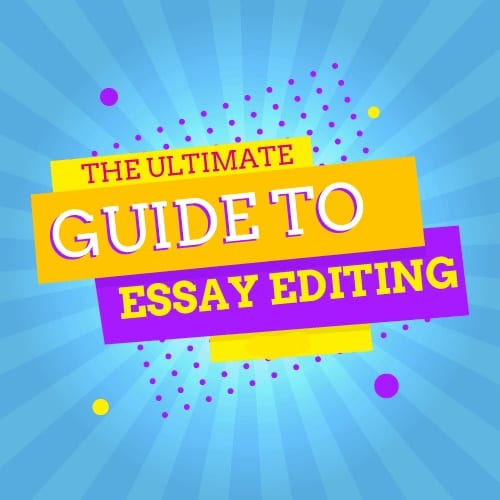
Everything You Need to Know About Editing an Essay
Let’s start with the news you may not want to hear:
Whether you’re a freshman who is about to submit your first major essay or a seasoned PhD scholar who is hoping to publish your work in a journal, it’s critical that you comprehensively edit and proofread every essay you write.
Yep. Every Single One.
Otherwise, you’d be wasting all the hard effort you’ve invested in writing the essay in the first place and accepting average grades when you could have achieved GREAT grades.
Amazingly, a massive 60% of college students in the United States have never written a formal essay.
If you’re new to the essay writing lark, need to refine your skills, or are just fed up with mediocre grades, the editing process is crucial.
But what exactly is essay editing, what does it involve, and how can you do it with minimal effort?
What’s in this guide?
This fantastic guide to editing an essay will introduce you to the following:
- What essay editing is and the process editors follow to refine, polish, and perfect academic papers, dissertations, and theses.
- The four key components of a great essay and the role they play in the essay editing process.
- How essay editing strategies work every single time.
- Top tips for editing an essay with minimal effort.
- A ton of free printables, checklists, and templates will make editing an essay a walk in the park.
- Some essay hacks that will help you impress your professor.
- An argumentative essay template that will help guide your writing efforts.
So, let’s get on with it.
Part One: An Overview of Essay Editing
What Does Editing an Essay Involve?
Essay editing involves refining a draft document to improve cohesion, flow, and readability while ensuring that any grammatical, punctuation, and spelling errors are corrected.
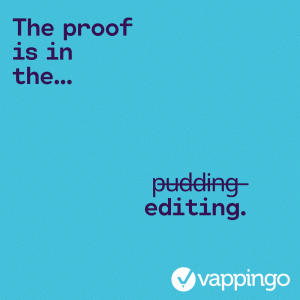
On a high level, essay editors perform four tasks to make your essay better:
- Structural editing: Looking at the paper as a complete unit to identify and address any significant structural problems.
- Substantive editing: Finding and addressing any issues associated with the organization, readability, clarity, and flow of the paper.
- Copy editing: Significantly improving the mechanics of the manuscript as a whole.
- Proofreading: Fixing any remaining spelling, grammar, punctuation, and style errors in the document.
Let’s look at each of these essay editing types in more depth.
What are the Different Types of Essay Editing?
The process that an editor will follow to edit an essay will vary from paper to paper depending on the standard of the written English, the effectiveness of the document structure, and the clarity of the argument.
What do I mean by this?
Some essays may need a lot more work than others.
However, generally speaking, there are four different types of editing.
The Four Types of Essay Editing
- Developmental and Structural Editing: This stage involves a macroscopic evaluation of the dissertation’s overall framework. The editor critically assesses the purpose and the central themes, collaborating with the author to develop a robust outline that enhances the organization and flow of the narrative. This phase ensures that the dissertation presents a cogent hypothesis, structured arguments, and a strategic direction. Should the first draft lack coherence, a comprehensive rewrite might be more beneficial than basic editing. The editor will refine the structure, excise repetitive elements, and highlight any logical discrepancies to fortify the integrity of the argument.
- Substantive Editing: During this intensive phase, the editor delves into the document’s intrinsic composition, scrutinizing the organization, style, and language for precision and clarity. Substantive editing is a meticulous process that may involve significant rewriting to articulate the central thesis clearly and to present supporting arguments logically. The editor’s goal is to enhance the flow of ideas, improve transitions between paragraphs, and ensure the discourse unfolds with coherent reasoning.
- Copy Editing: As the document nears completion, copy editing becomes paramount. This detailed analysis focuses on the linguistic mechanics of the text. The editor’s role is to rectify syntax, grammar, punctuation, and spelling, ensuring the author’s original tone and voice remain intact. This stage also demands uniformity in formatting and stylistic coherence. The editor will address any inconsistencies and verify the accuracy of references to visual aids, such as images, tables, and figures.
- Proofreading: The final stage of the editing process, proofreading, is a critical last check for minor errors that may have slipped past earlier reviews. This is not just a superficial overview but a thorough inspection for typographical, punctuation, or grammatical inaccuracies. Additionally, the proofreader ensures that the document complies with the specific style guide, fine-tuning diction and scrutinizing the overall presentation to uphold the highest academic standards. The proofreader will also check the appropriate style guide has been followed. For instance, the APA style guide.
Is Editing an Essay the Same as Proofreading?
No. Editing and proofreading are entirely different processes. To put it simply, editing is improving the overall quality of the writing, while proofreading is fixing all remaining minor mistakes.
Editors and proofreaders use completely different skillsets:
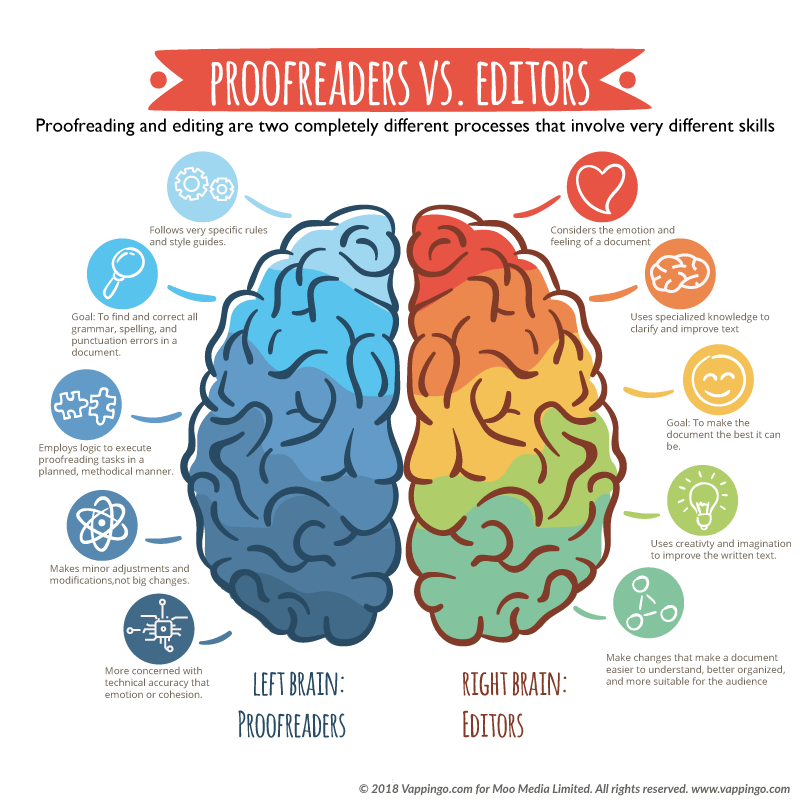
To learn more, take a look at our snazzy guide to the difference between editors and proofreaders.
What are Professional Essay Editors?
Professional essay editors are seasoned essay experts who know exactly what it takes to craft the perfect essay.
Editors can specialize in developmental editing, substantive editing, copy editing, proofreading or a combination of all three.
Vappingo’s essay editors follow a three-step process that spans the developmental, copy editing, and proofreading functions.
Three-step Essay Editing Process
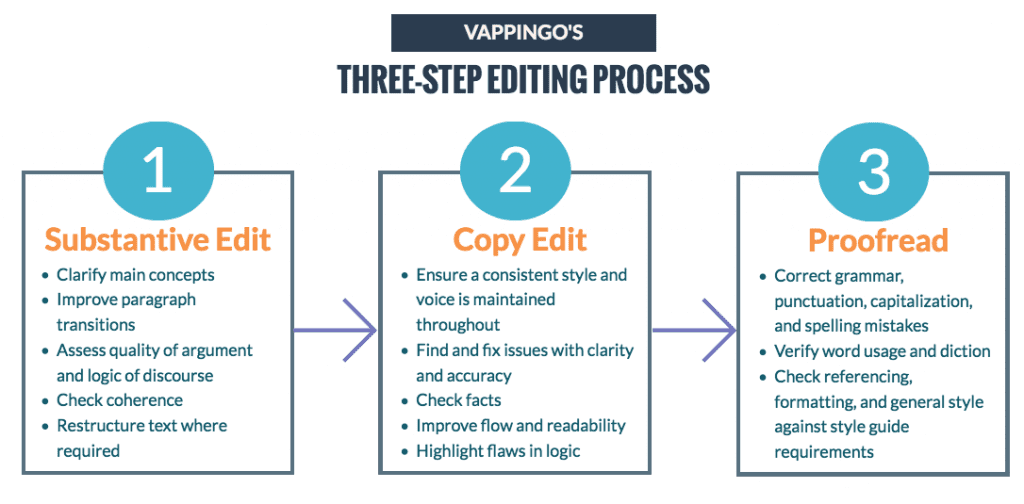
So, now you know what editing is.
I can’t stress this enough: When it comes to your final grade, every essay counts. As such, editing is imperative.
If you don’t want to use an academic editing service to help you edit your essay effectively with the least amount of effort, you’re going to need to perfect the art of editing for yourself.
Question is:
How can you go about this?
Part two of this guide to editing an essay contains all the top editing tips you need to make your essay better.
Psst: Our native English editors have reviewed thousands of essays and know what it takes to create papers that get top grades. Order our editing services now, and we’ll help you stand out from the crowd.
Part Two Editing an Essay for Better Grades
When you’re editing your essay, you will typically have one objective in mind: To get the best possible grade.
Of course. you could hire an academic editing service to assist you. This is the best option. You can read more in our guide to is academic editing cheating?
Alternatively, there are several editing strategies you can use to make sure your essay shines.
How do I Make my Essay Better?
Before we dive in, let’s quickly review the four factors that contribute to a great essay.
- Structure and organization: Your paper should be well structured, easy to read, and flow well. A clear red line of thread should be apparent from the introduction through to the conclusion.
- Language and formatting: It’s not just about putting all the words together to argue your case; it’s about using the right words in the right voice and tone. A single word in the perfect place can transform an essay from a reasonable effort into a great paper. Likewise, a silly error can undermine your entire credibility. The fonts you use and the way the citations, references, and general layout of your essay are formatted will all have a direct impact on the credibility of the final paper.
- Coherence, content, and analysis: Are the key facts and arguments you’re presenting useful, relevant, and succinct? Are your claims supported by evidence?
- Purpose: After reading your essay, the reader should be able to summarize your major position using just a couple of sentences. Have you answered the question correctly?
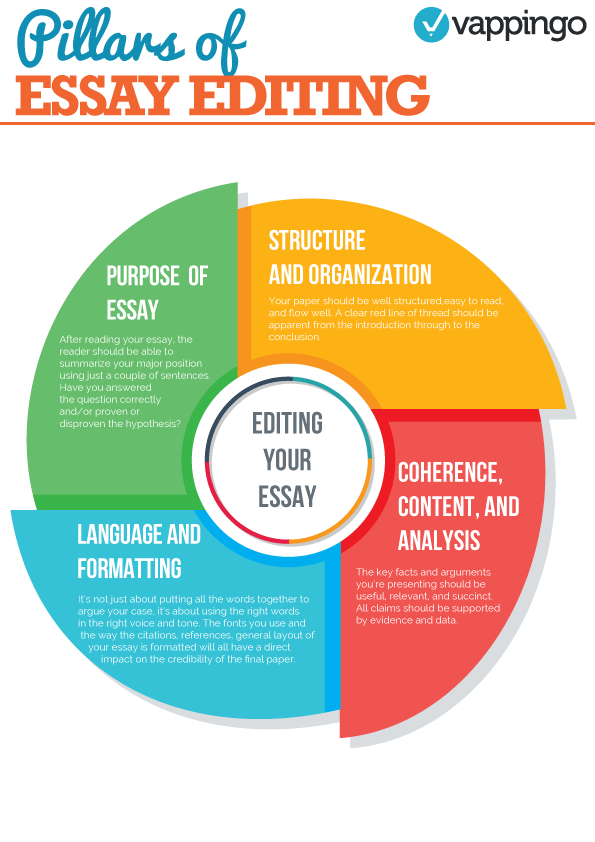 Strategies for Editing an Essay
Strategies for Editing an Essay
So, we now know why essay editing is important, what it involves, and what high-level features editors are interested in.
Let’s get down to the nitty-gritty and look at the specific strategies for editing an essay you can use to make sure your essays are effective, powerful, and memorable.
Here are five essay editing strategies that students frequently use:
- Peer editing
- Following an essay editing checklist
- Using essay editing tools
- Following general tips to make an essay sound better
- Looking out for common mistakes
1. Peer Editing
Peer editing can be a useful essay editing strategy that involves asking a friend or colleague to read your essay before giving you useful input and guidance on how it can be improved.
It’s a great way to get a second set of eyes to spot mistakes and point out any flaws in the argument. It can also be a mutually beneficial process that helps the peer editor to identify how his or her writing can be improved.
Peer editing can be helpful in four main ways:
- It helps you to view your essay from a reader’s perspective
- It allows you to gain insights into what’s working well and access suggestions as to what can be improved
- It gives you a chance to revise the essay, dissertation, or manuscript with the target audience in mind
- It provides you with a solid list of actions you can take to revise and enhance the essay
You can learn more about peer editing by checking out our peer editing checklist.
2. Following an Essay Editing Checklist
An editing checklist provides a simple list of things you should be on the lookout for when reviewing and revising your essay.
Let’s remind ourselves of some of the four pillars of a great essay:
We have created a handy essay editing checklist that takes into consideration these four pillars. You can download and print this free PDF by clicking on the image below.
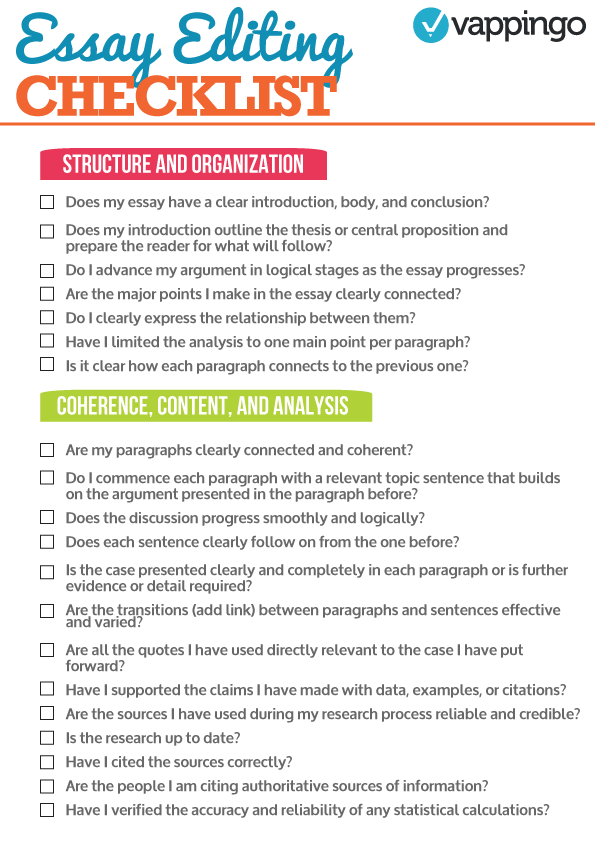 Structure and Organization
Structure and Organization
- Does my essay have a clear introduction, body, and conclusion?
- Does my introduction outline the thesis or central proposition and prepare the reader for what will follow?
- Do I advance my argument in logical stages as the essay progresses?
- Are the major points I make in the essay clearly connected? Do I clearly express the relationship between them?
- Have I limited the analysis to one main point per paragraph?
- Is it clear how each paragraph connects to the previous one?
Coherence, content, and analysis
- Are my paragraphs clearly connected and coherent?
- Do I commence each paragraph with a relevant topic sentence that builds on the argument presented in the paragraph before?
- Does the discussion progress smoothly and logically?
- Does each sentence clearly follow from the one before?
- Is the case presented clearly and completely in each paragraph, or is further evidence or detail required?
- Are the transitions between paragraphs and sentences effective and varied?
- Are all the quotes I have used directly relevant to the case I have put forward?
- Have I supported the claims I have made with data, examples, or citations?
- Are the sources I have used during my research process reliable and credible?
- Is the research up to date?
- Have I cited the sources correctly?
- Are the people I am citing authoritative sources of information?
- Have I verified the accuracy and reliability of any statistical calculations?
Purpose
- Is my thesis, central proposition, or main argument presented in the introduction?
- Do I take a position on this topic? If so, do I make this position clear throughout the essay?
- Do all the major points I make in the essay contribute to achieving its overall purpose?
- Does the conclusion summarize my argument in a compelling way and pull together the analysis that was presented within the essay?
Language and formatting
- Have I used clear and easy-to-understand language?
- Have I fully explained my ideas and opinions?
- Is my argument presented per the needs, comprehension, and background of the target audience?
- Have I proofread the file for grammar, punctuation, capitalization, and typographical errors?
- Have I referenced all the sources I have used per the formatting conventions of the required style guide?
- Have I applied consistent formatting and referencing styles throughout the essay?
- Have I clearly delineated between my ideas and those of the authors I have cited?
- Is the essay within the required word limit?
- Is all the information contained within the bibliography correct?
Of course, this is just a sample checklist. You may wish to create your own essay editing checklist.
Check out our free essay editing checklist.
3. Using essay editing tools
There are a ton of tools out there that can make the essay editing process more straightforward and a bit more fun.
Take a look at our essay tips for an overview of some great ways to make writing an essay easier.
4. Looking out for common mistakes
There are some mistakes that even the most seasoned writers make again, and again, and again.
If you’re relatively inexperienced at writing essays, you should review our guide to common English mistakes.
This will help you to familiarize yourself with some of the errors that have a habit of rearing their ugly heads.
Once you become a more experienced editor, you will start to get a feel for the mistakes that you have the propensity to make on a regular basis. For example, in my rush to churn out copy, I frequently mistype “then” instead of “than.” It’s shockingly easy to do, yet can completely change the meaning of a text.
 Oops!
Oops!
When I proofread the final draft, I always double check for this minor error.
5. Following top tips for editing an essay
You can also follow some great essay tips to make sure your paper shines.
Don’t edit as soon as you finish the first draft of the paper
I get it. It’s business as usual for students to be writing essays at the last minute, and you may not have the luxury of a few days to take a break from the essay writing process.
However, if you can, you should.
The reason for this is simple: Your brain will be too familiar with the content of the essay. As such, you’ll see what you think is in the essay, not what’s there.
The human brain is very easily tricked.
Don’t believe me?
Take a look at the following:
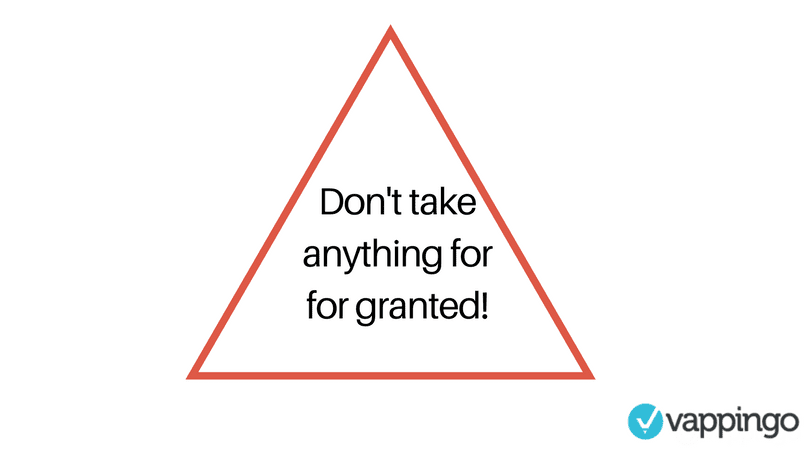 See any problems? Are you sure? Keep looking, and you’ll see it eventually.
See any problems? Are you sure? Keep looking, and you’ll see it eventually.
This, and these other proofreading memes, show why proofreading your own work is difficult.
If you start editing an essay too soon after finishing it, you’ll likely be incapable of spotting all the typos, unsupported arguments, and grammar slip-ups.
Leave it to one side for a while to give you some space to clear your head.
You’ll find that you’re much better placed to edit your essay from a fresh perspective if you take this approach.
Create your own essay editing checklist
Once you have become accustomed to using our essay editing checklist, keep an ongoing list of the mistakes you make most frequently and use this to create your personalized essay editing checklist.
Use software and automation tools… but sparingly
Have you got access to some great editing and proofreading software that streamlines the editing process?
That’s great.
But know this: You should never depend on it in isolation.
Even the most innovative spelling and grammar-checking tools can miss obvious spelling, punctuation, capitalization, and grammar errors.
That’s because they are incapable of reading text within the context in which it is intended to be used.
Let’s look at an example.
According to one very famous grammar-checking software, there are no errors in the following:
 This is really quite odd because every sentence is replete with errors.
This is really quite odd because every sentence is replete with errors.
What we learn here is that context is important.
Try running the following through a grammar checker:
Thinking it was open, the window was really closed.
My grammar checker advises me to remove the word “really” (more on that later) and verify whether the sentence has been written in passive voice.
This sentence was not written in passive voice. However, we did have the strange phenomenon of a thinking window.
And that brings us to the next problem with grammar-checking software: It is only as good as your ability to identify grammatical errors.
Grammar checks regularly flag completely acceptable grammar as bad, and vice versa. This is not due to software errors; it is because grammar is a very complex beast.
Use spelling and grammar checkers by all means, but always remember that there is no substitute for a trained human professional proofreader.
Edit the paper according to the essay outline
As I have stressed throughout this article, it is imperative that your essay flows well, remains consistent, and responds to the writing prompt.
Every single element of your paper—including the title, introduction, body paragraphs, and conclusion—should all be aligned with the underlying goal of your essay.
Do you know what the best essay writers do to achieve this objective?
They create an essay outline.
It may look something like this:
Or it could be completely different. The point is that effective essay writers develop a thesis statement and then follow a clear essay outline.
This ensures they present their argument in a logical manner, and this naturally gives the essay a clear structure.
Here’s a sample plan you may like to use:
When you are editing your essay, you should consider your planned outline and verify that the paragraph structure and format take the reader on a meaningful journey along your train of thought.
If you need more help with essay formatting and planning, check out our essay formatting template.
Remove all the redundancies and fluff
The best essays are those that keep the argument concise and to the point.
I hear ya! You have a word count to meet.
But brevity is key.
Get rid of fillers and redundant words, phrases, and terms. Filling the paper with mindless jargon is not the right thing to do.
Why?
- They dilute the argument presented in your essay.
- They waste the reader’s time. If the reader is your professor, he or she isn’t going to appreciate that!
- They make the essay more difficult to understand.
If you have included words to meet the word count as opposed to adding value to your paper, give them the chop.
I have developed a list of 17 words or phrases that typically serve no purpose whatsoever other than to use up words. Let’s have a look at them.
Words and Phrases You Shouldn’t Use in an Essay
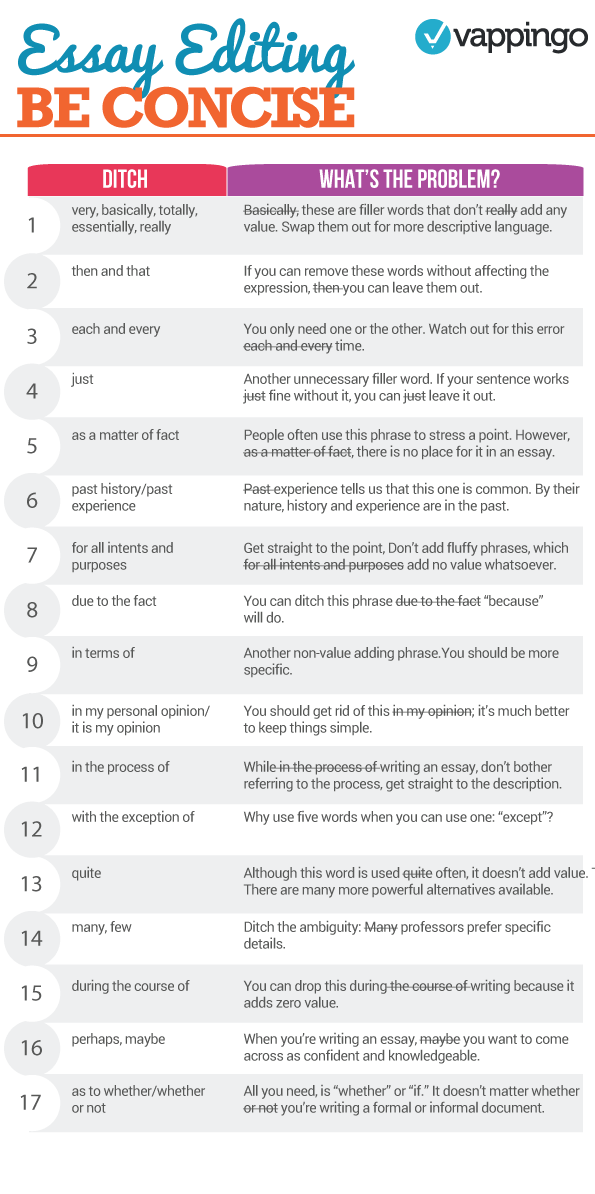 Very, Basically, Totally, Essentially, Really
Very, Basically, Totally, Essentially, Really
Basically, these are filler words that don’t really add any value. Swap them out for more descriptive language.
Instead of this: I am really tired after playing basketball.
Try this: I am shattered after playing basketball.
Then and That
These are words that you should only use if you’re trying to clarify something. If you can remove the word without affecting the expression, then you can leave it out.
Each and every
People frequently use these filler words to express a feeling of frustration. However, you only need one or the other. Watch out for this error each and every time.
Just
Again, this is another unnecessary filler word. If your sentence works just fine without it, you can just leave it out.
As a Matter of Fact
We all love a bit of drama, and people frequently use this phrase in spoken communications to stress a point. However, as a matter of fact, there is no place for it in an essay.
Past history/past experience
Our past experience tells us that this one is very common. By their nature, history and experience are in the past. Delete the word past.
As to whether/whether or not
All you need is “whether” or “if.” It doesn’t matter whether or not you’re writing a formal or informal document.
For all intents and purposes
If you have a point to make, make it. You don’t need to add fluffy phrases such as these, which for all intents and purposes add no value whatsoever.
Due to the fact
You can ditch this phrase due to the fact “because” will do.
In terms of
Another non-value-adding phrase. Use of this indicates that your writing is weak. Be more specific in terms of what you are saying. Instead of saying, “…in terms of cost, the food was expensive,” you can say, “the food was expensive.”
In my personal opinion/It is my opinion
When you’re writing an essay, you are inherently expressing your opinion. Not that of your friend. You should get rid of this in my opinion; it’s much better to keep things simple.
In the process of
While in the process of writing an essay, don’t bother referring to the process, just get straight to the point of describing it.
With the possible exception of
Why use five words when you can use one: “except.”
Quite
Even though this word is used quite often, it doesn’t add any value. There are many more powerful alternatives available.
Many, few
Ditch the ambiguity: Many professors prefer specific details.
During the course of
You can drop this during the course of writing because it adds zero value.
Perhaps, maybe
When you’re writing an essay, maybe you want to come across as confident and knowledgeable.
Getting rid of these words and phrases will automatically lead to better, more concise essays.
Of course, if brevity is causing you word count headaches, you can always insert these words and phrases to increase the word count without committing a major grammar sin 😉
Proofread last
The very last thing you should do before submitting your essay is to proofread it one final time.
Yes, you will have picked up some errors while you were editing the essay. However, during the editing process, you were not fully focused on finding grammatical, punctuation, capitalization, and spelling mistakes.
Once you have completed the editing process, go back through the essay with the sole intention of finding those last remaining pesky errors.
Take a look at our guide on how to proofread an essay for some top tips that are guaranteed to help you find even the most minor mistakes in your writing.
Conclusion
As the following pie chart shows, you should invest as much time in the process of editing an essay as you do in writing it.
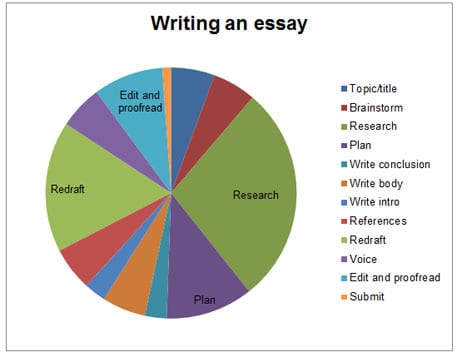
If you go that extra mile and follow these strategies and tips for editing an essay, you will take your papers up a few notches and really impress your professor.
If you’re stuck in that “write it and submit it” habit, now is the time to change. You can quickly and easily transform your essay for the better using these simple techniques.
What strategies do you use for editing an essay?
Be honest: How much time do you invest in editing your essays?

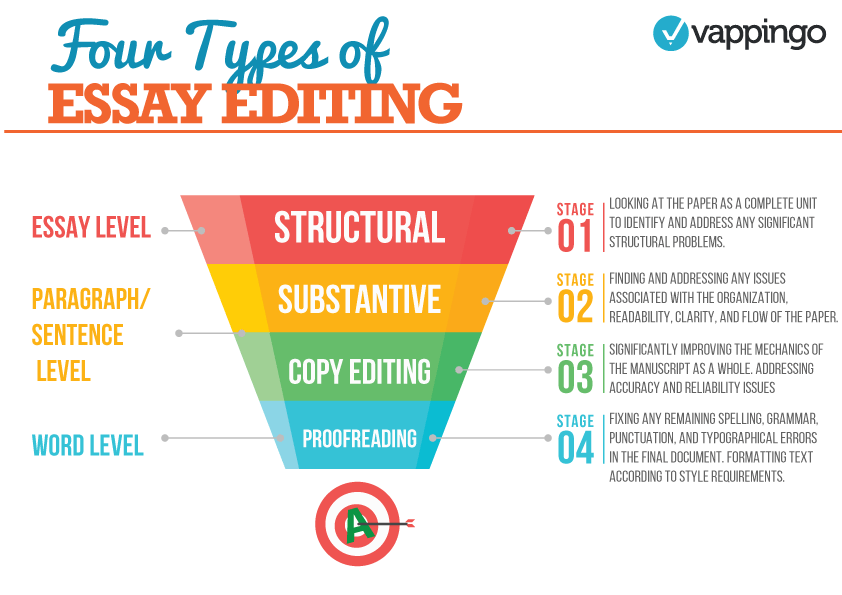
15 thoughts on “The Ultimate Guide to Editing an Essay in 2023”
Comments are closed.